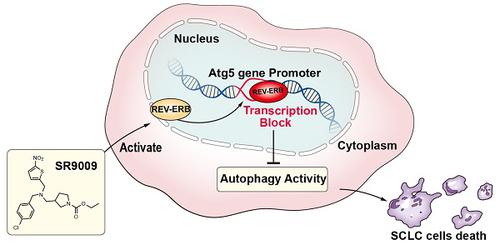Theranostics ( IF 12.4 ) Pub Date : 2020-01-01 , DOI: 10.7150/thno.42478 Weitao Shen 1 , Wei Zhang 1 , Weilin Ye 1 , Haihong Wang 2 , Qingxi Zhang 3 , Jie Shen 1 , Qingsha Hong 4 , Xiang Li 5 , Ge Wen 6 , Ting Wei 1 , Jian Zhang 1

|
Rationale: The circadian clock coordinates cell proliferation and metabolism and impacts the progression of some diseases, particularly cancer. Pharmacological modulation of the circadian machinery may be an effective therapeutic approach for treating cancer. SR9009 is a specific synthetic agonist of the REV-ERBs, essential circadian clock components. However, the potential efficacy and antitumor mechanism of this drug in small-cell lung cancer (SCLC) remains poorly understood.
Methods: Here, we used chemosensitive cells (H69 and H446) and the corresponding chemoresistant cells (H69AR and H446DDP) to assess the efficacy of the REV-ERB agonist SR9009 for the treatment of SCLC in vitro and further validated the antitumor effect in subcutaneous tumor models of SCLC. Then, we determined whether REV-ERBα was correlated with the anti-SCLC effect of SR9009. Chromatin immunoprecipitation (ChIP) sequencing assays were conducted to identify potential DNA sequences directly regulated by REV-ERBα. Autophagy regulation by REV-ERBα and its possible mechanism in SR9009-based SCLC therapy were analyzed.
Results: Here, we showed that the REV-ERB agonist SR9009 is specifically lethal to both chemosensitive and chemoresistant SCLC cells. REV-ERBα was involved in the antitumor effect of SR9009 in SCLC. The core autophagy gene Atg5 was identified as a direct downstream target of REV-ERBα and was suppressed by the REV-ERB agonist SR9009 in SCLC. Furthermore, the interaction of REV-ERBα with this autophagy gene impaired autophagy activity, leading to SR9009 cytotoxicity in SCLC cells.
Principal conclusions: Our study provided a novel viewpoint indicating that the REV-ERB agonist SR9009 could be a novel and promising therapeutic strategy in first- or second-line SCLC treatment. The anti-SCLC effect of SR9009 is mediated by REV-ERB dependent suppression of autophagy via direct repression of the autophagy gene Atg5.
中文翻译:

SR9009通过抑制自噬诱导REV-ERB依赖性抗小细胞肺癌作用。
原理:生物钟协调细胞增殖和新陈代谢,并影响某些疾病的进展,尤其是癌症。昼夜节律机制的药理调节可能是治疗癌症的有效治疗方法。SR9009是REV-ERB(一种基本的生物钟组件)的特定合成激动剂。但是,这种药物在小细胞肺癌(SCLC)中的潜在功效和抗肿瘤机制仍然知之甚少。
方法:在这里,我们使用化学敏感性细胞(H69和H446)以及相应的化学抵抗性细胞(H69AR和H446DDP)来评估REV-ERB激动剂SR9009在体外治疗SCLC的功效,并进一步验证了对皮下肿瘤的抗肿瘤作用SCLC的模型。然后,我们确定REV-ERBα是否与SR9009的抗SCLC效应相关。进行了染色质免疫沉淀(ChIP)测序测定,以鉴定直接受REV-ERBα调控的潜在DNA序列。分析了REV-ERBα的自噬调控及其在基于SR9009的SCLC治疗中的可能机制。
结果:在这里,我们表明,REV-ERB激动剂SR9009对化学敏感性和化学抵抗性SCLC细胞均具有致命的杀伤力。REV-ERBα参与了SR9009在SCLC中的抗肿瘤作用。核心自噬基因Atg5被鉴定为REV-ERBα的直接下游靶标,并被SCLC中的REV-ERB激动剂SR9009抑制。此外,REV-ERBα与该自噬基因的相互作用削弱了自噬活性,导致SCLC细胞中SR9009细胞毒性。
主要结论:我们的研究提供了一种新颖的观点,表明REV-ERB激动剂SR9009在一线或二线SCLC治疗中可能是一种新颖而有希望的治疗策略。SR9009的抗SCLC效应通过直接抑制自噬基因Atg5的REV-ERB依赖性自噬抑制来介导。






























 京公网安备 11010802027423号
京公网安备 11010802027423号